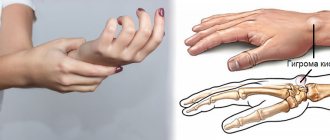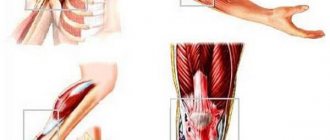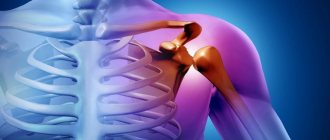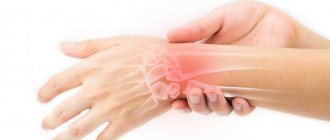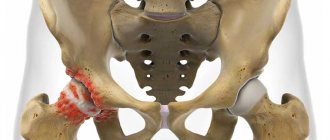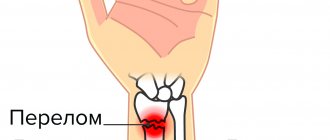The pain syndrome present in the wrist area causes serious discomfort to a person. This condition disrupts the usual way of life, since it becomes impossible to normally perform natural functional duties with the hands. Any motor activity is quickly interrupted, as the impulse enters the brain, the person instinctively tries to protect himself from pain.
Quite often, this condition is associated with an inflammatory process occurring in the tendons of the hand, and is called tendonitis. To understand how pain can be alleviated and how to cure the disease, it is necessary to study in detail the possible causes of its occurrence, characteristic symptoms, and preventive measures that prevent its occurrence.
What it is
Wrist tendonitis is an inflammatory process localized in the area of the tendon weave, accompanied by pronounced pain and limited motor ability of the hand.
Most often, this process occurs as a result of spraining the ligaments of the wrist joint. One or more wrist ligaments may be damaged, with simultaneous damage to soft tissues, accompanied by swelling and pain.
Despite the fact that the disease is characterized by an inflammatory process, it has recently become known that traumatic lesions of the tendon joints are not associated with the concept of “tendinitis”. In fact, the deterioration of the wrist occurs as a result of the loss of the connective tissue of the body, which ensures its strength and elasticity (collagen), as well as thinning of the fibers, an increase in glycosaminoglycans, which are responsible for the presence in the tissues of the optimal amount of water necessary for the formation of cartilage tissue.
During muscle contraction of the wrist area, the limb experiences a constant load on the joint. Overexertion of tendons leads to their damage due to frequently repeated monotonous movements or excessive use of physical effort. Damage provokes thinning of the fibrous structures of the soft tissues of the wrist, resulting in degenerative changes in the fibers.
If you experience discomfort in the wrist area, you should consult a rheumatologist. If there is no improvement after prescribed conservative treatment, surgical intervention is recommended.
How to treat
Treatment of tendinitis of the wrist joint is carried out using complex methods. First of all, it is necessary to provide complete rest to the injured hand. To do this, use special bandages that fix the hand and prevent its displacement.
Basic treatment
Drug therapy depends on the form of the disease and the severity of symptoms.
Table No. 1. Medicines for the treatment of tendinitis.
| Group of drugs | Effect | Instructions for use |
| Antibiotics | Suppress the activity of pathogenic bacteria | Prescribed if tendinitis is infectious in nature. Conduct a course of intramuscular injections or take medications orally |
| NSAIDs | Suppress the inflammatory process, eliminate swelling and pain | Prescribed for any form of disease. The drugs are taken orally, as well as in the form of ointments directly to the affected area. |
| Corticosteroids | Have a pronounced anti-inflammatory and anti-edematous effect | Prescribed for severe forms of the disease. The drugs are taken orally or injected into the bursa |
Medicines are prescribed by a doctor taking into account the severity of the disease. If drug therapy is ineffective or purulent complications develop, surgical intervention is required.
It involves cutting the skin and subcutaneous tissue in the wrist area. Then the wound is washed with antiseptics, the pus is removed and drained. After it is completely cleansed, suturing is performed.
Additional Methods
They are prescribed by doctors to enhance the effect of therapy and for rehabilitation.
Table No. 2. Assistive therapy.
| Additional treatments | Description |
| Therapeutic physical education You need to start developing your hand with simple exercises | Specially designed exercises help get rid of pathology identified in the early stages of development. In the later stages, physical education restores the lost range of motion of the limb and prevents the development of joint stiffness. There are many different complexes; a specialist will tell you about the most effective ones in the video in this article. |
| Physiotherapy
| Treatment with physical methods is prescribed to eliminate symptomatic manifestations, improve blood circulation in the joint, and prevent complications. The following procedures will help cope with the disease:
|
A properly selected diet plays an important role in the treatment of tendon pathology. It is healthy to eat fatty fish and seafood, meat, milk and dairy products, fresh vegetables and fruits, and nuts. Tendonitis of the wrist joint is a pathology that significantly worsens a person’s quality of life. In the early stages, the disease responds well to treatment. Competent therapy in the later stages allows you to achieve stable remission.
Causes
The main factor influencing the development of radiate carpal tendonitis is increased force on the joint. The anomaly often occurs in professional athletes and hyperactive people. The risk group also includes people whose professional activities involve frequently repeated movements of the same muscle groups of the wrist (pianists, secretaries, seamstresses).
Excessive force on the hands leads to degradation of joint tissue and causes severe pain. Pathological changes include:
- accumulation of large amounts of salt in the joints, which leads to the formation of hard growths and damage to the tissue composition;
- death of cell tissue in the affected areas;
- tendon and cartilaginous tissue degeneration.
The development of tendon pathology occurs for the following reasons:
- the presence of joint diseases (arthritis, spondylitis);
- damage to tendon ligaments of varying severity;
- the presence of infectious and bacterial diseases in the body;
- diseases of the spinal column;
- diabetes;
- pathological features of the anatomical structure of the hands;
- congenital disorders of formation, joint neuropathy.
Pathological changes can be triggered by lifting heavy objects or dropping a heavy object into the wrist area.
Symptoms
The most obvious symptom of wrist tendinitis is pain. If a person is involved in professional sports or his work specialty involves the repetition of certain manipulations with his hands, and he has discomfort in the radial joint, it is highly likely that the cause of the pain is tendinitis.
The main symptoms of inflammation development:
- pain inside the wrist that occurs only with physical exertion on the joint;
- redness, increased local temperature of the skin of the inflamed area;
- the presence of a crunch during flexion and extension of the wrist joint;
- swelling of epithelial tissue in the affected area;
- limitation of physical activity of the hand, difficulty in making grasping movements;
- The pain syndrome is progressive and becomes unbearable closer to night, which can cause insomnia.
You should not try to diagnose the disease yourself, since the symptoms listed may be signs of another pathology . If pain is present in your wrist, it is recommended to seek medical attention. An accurate diagnosis gives positive prognoses for treatment.
Danger of disease
Tendinitis is not life-threatening, but it does significantly reduce the quality of life. Areas adjacent to the affected area may become inflamed, leading to pathologies such as bursitis, arthritis or myotendinitis.
If treatment is not done in a timely manner and tendonitis is chronic, tendon rupture may occur.
This will entail surgical intervention, after which it will not be possible to return to a full life: the load on the operated arm or leg will have to be limited as much as possible. If difficulties arise when walking, dressing, squatting and other simple actions, you need to pay attention to this alarm signal from the body and be sure to visit an orthopedic doctor.
Diagnostics
The difficulty in establishing a diagnosis lies in the similarity of symptoms with other anomalies of the joint and adjacent tissue structures. Therefore, to determine wrist tendonitis, differential diagnosis is used to distinguish the disease from tendon rupture, bursitis, or infectious tenosynovitis.
At the first stage of diagnosis, a general examination of the patient and anamnesis are taken. The general clinical picture consists of visualization and palpation, which determine the location of the pain syndrome, the presence of swelling, and changes in skin color.
The next stages of the diagnostic study are:
- radiography;
- ultrasonography;
- general blood analysis;
- echography.
Magnetic resonance and computed tomography are used to determine areas of degenerative tissue changes.
Treatment
Treatment of wrist tendonitis at the onset of development is carried out conservatively. The main methods include the following manipulations:
- to avoid the risk of violating the integrity of the tendons, the affected joint is immobilized;
- Cold compresses are applied to the affected area 3–4 times a day;
- to reduce the activity of joint movements, a special splint or plaster cast is applied to it.
The patient is also prescribed painkillers (Hydrocortisone, Piroxicam, Indomethacin, Ibuprofen, Methylprednisol). In some cases, antibiotics may be prescribed.
Physiotherapy
If the disease is not chronic, the patient is prescribed physiotherapeutic measures.
Physiotherapy methods are:
- magnetic resonance therapy (low-frequency magnetic fields affect articular surfaces, reducing pain discomfort and inflammation);
- ultrasound (relieves inflammation, promotes rapid tissue regeneration);
- laser therapy (has an analgesic effect, removes salts, improves oxygen flow);
- in the chronic course of the disease, physiotherapy includes taking mud baths and applying paraffin baths.
Folk remedies
Anti-inflammatory therapy with folk remedies has an effect only in the initial period of disease development.
Treatment methods:
- To improve the general condition and reduce pain, curcumin should be added to food (no more than 0.5 g per day);
- Infusion of ginger root and passaparia (pour 1 teaspoon of the mixture with 1 glass of boiling water, take 2 times a day);
- External remedy with salt: dissolve 1 tbsp in 1 glass of water. a spoonful of salt, soak gauze in the solution, put it in the freezer for 5 - 10 minutes, then take it out and apply it to the sore wrist. It is necessary to keep the product until it dries completely.
Surgical intervention
If the applicable treatment methods do not bring the desired result, and the patient has a serious injury to the tendon muscles, surgery is prescribed. This involves removing scarred tissue and affected areas of tendons. The rehabilitation period after surgery is 2–3 months.
Results of using shockwave therapy in the treatment of tendinitis
Shock wave therapy (SWT) helps to avoid surgical intervention - a modern effective method of treating many diseases, including inflammation of tendon tissue, accompanied by an increase in the level of salts and calcifications.
GUTA CLINIC specialists are fluent in the UVT method and conduct treatment sessions using the PiezoWave device (RichardWolf, Germany). The doctor acts on the damaged area with a shock wave of a certain frequency, applying PiezoWave sensors to it.
The action of this innovative system allows you to achieve the following results in the treatment of tendinitis
:
- calcium salts in the tendons are destroyed;
- the pain first eases, then disappears completely;
- local blood circulation is activated;
- metabolic processes are stimulated;
- the inflammatory process is stopped;
- tissues and motor functions are restored.
The dynamics of recovery and lasting therapeutic effect are observed from the first procedures. Their intensity and regularity vary from person to person. Also, the high value and achievement of a positive result of shock therapy in more than 90% of cases of the disease is determined by timely consultation with a doctor.
Prevention
It should be understood that if you do not approach sports professionally, exercise can be both beneficial and harmful. To prevent the development of wrist tendonitis, it is recommended to adhere to the following tips:
- If your professional activity involves long-term monotonous work, it is necessary to take breaks periodically.
- Before starting sports training, you should first warm up your muscle mass, thereby preparing it for increased physical impact.
- You need to be attentive to situations in which there is a possibility of injury.
If a person experiences serious painful discomfort in the wrist area, this should not be attributed to simple fatigue; perhaps these are signs of tendonitis, especially if professional activity is associated with frequently repeated monotonous hand movements. In this case, it is better to consult a doctor who will conduct an individual examination and give competent recommendations for treatment.
If you find an error, please select a piece of text and press Ctrl+Enter. We will definitely fix it, and you will get + to karma
